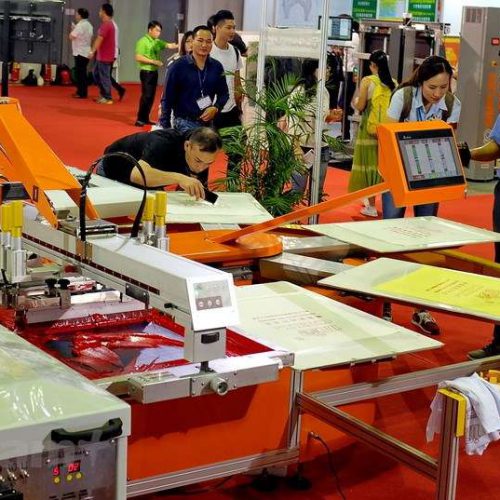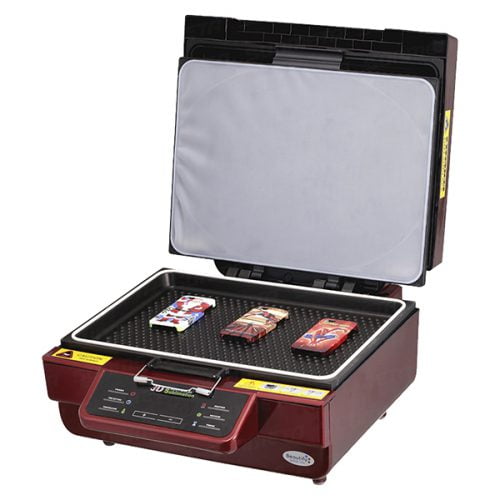UV printing technology cures ink by UV light. Therefore, it is necessary to use printing inks containing some special ingredients, which react with UV light to quickly change from liquid to solid.
What is UV printing ink?
Because UV printing is an inkjet technology, UV printing ink is mainly liquid ink . This ink dries quickly (solidifies) when exposed to UV light thanks to the photochemical process. The ink solvent does not evaporate or penetrate the printed material, but dries and adheres firmly to the surface. This is why UV printing is durable and can be printed on non-absorbent materials such as stone, plastic, glass, etc.
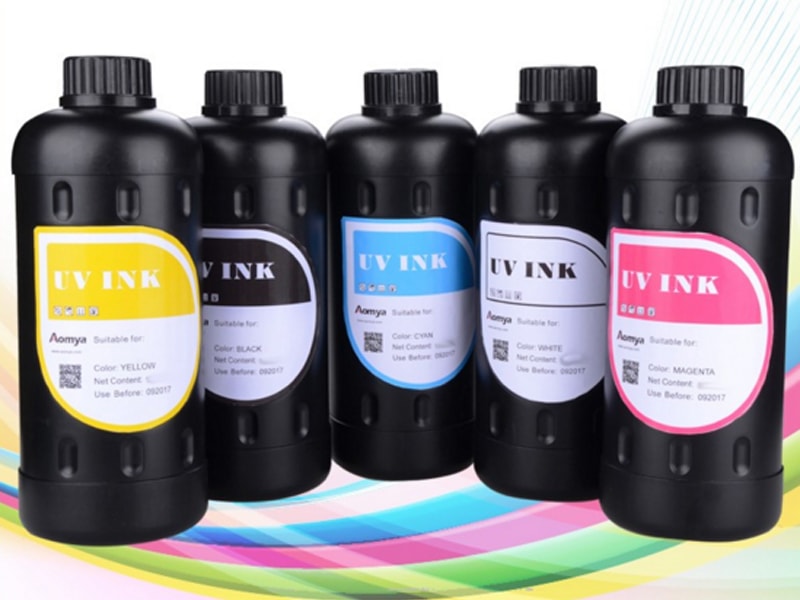
UV ink composition is not different from other liquid inks, also has solvents, pigments (coloring) and binders. However, there are some other substances that when exposed to UV rays, the ink dries quickly. In general, printing ink consists of the following components:
- Adhesives (Oligomers)
- Monomers
- Pigment
- Auxiliaries or photochemicals, photoinitiators
- Additives
The content and function of substances in UV printing ink are shown in the table below:
| Components (Components) | Content (Content) | Main functions (Principal functions) |
| Adhesives (Oligomers) | 40 – 50% | Substance that determines the essential properties of the ink (print stability, print performance, resistance, etc.) |
| Pigments | 15 – 20% | Colorant to ink and achieve required color fastness |
| Monomers | 5 – 20% | Substances affecting ink adhesion to the surface of printed materials |
| Photoinitiators | 5 – 12% | Reacting with UV light helps ink from liquid to solidify quickly |
| Additives | 1-8% | Some other substances reinforce color fastness, color fastness, etc. |
Adhesives (Oligomers)
In the oil and gas industry, Oligomers are formed in all the C2, C3 and C4 hydrogenation reactors of ethylene plants and other petrochemical production facilities. It is a mixture of unsaturated components. C4 to C20 with about 90% aliphatic and 10% alkanes plus alkenes.
| Oligomer type | Performance effect |
| Epoxy Acrylate | Increased reactivity, hardness |
| Aliphatic urethane acrylate | Increased flexibility, toughness, hardness, chemical resistance |
| Acrylate aromatic urethane | Increase flexibility, toughness; increased reactivity, hardness, chemical resistance; cost reduction (compared to aliphatic) |
| Polyester acrylic | Increased humidity; reduce viscosity |
| Acrylate acrylic | Increase adhesion |
Monomers
A monomer a small molecule chain that can combine with other molecules to form an oligomer or polymer. At that time, the monomers also have the same effect as oligomers, which are adhesives, helping the ink to better adhere to the surface of the printed material. At the same time, shorten the drying time of UV printing ink when exposed to UV light.
Pigment
A pigment, dye or pigment is a material that changes the color of reflected or transmitted light as a result of selective absorption of a wavelength of light. This physical process can be caused by fluorescence, phosphorescence or other forms of luminescence.
They are usually pigments. When UV printing, these pigments adhere to the surface of the printed material, forming a thin, slightly bumpy layer that can be felt to the touch.
Auxiliaries or photochemicals, photoinitiators
They can be aromatic ketones or esters, acetophenones, benzoic derivatives or benzyl ketals. Its function is as a UV catcher, absorbing the energy of UV light photons – and resulting in spontaneous decomposition of the initiators into highly reactive fragments known as free radicals. The fragments start a polymerization chain at a high rate, leading to a polymerization that solidifies the ink film.
Additives
Some additives in UV ink and their content are shown in the following table:
| Name | Status/Occurrence rate (%) | Function |
| JAR-1 Varnish | 1-20 . viscous liquid | Support the ink drying process |
| JAR-8 . Accelerator | Liquid 1-4 | Initialize the image for color ink. |
| Accelerator JAR-15 | Liquid 1-4 | Initialize images for all inks. |
| Additives JAR-16 | Liquid 3-5 | To enhance adhesion and waterproof. |
| Additives JAR-18 | Liquid 1-3 | To enhance adhesion and waterproof. |
| Additives JAR-20 | Flour 5-20 | Increase the adhesion of printing ink |
| Additives JAR-22 | 1-2 . viscous liquid | Increases adhesion and prevents ink from falling off the substrate surface. |
Some notes when using UV ink:
- Regularly monitor the composition and temperature of the aqueous solution to prevent it from mixing in the ink when printing
- It is recommended to place a temperature monitor of the ink trays and ink tubes to avoid distortion of the ink when the temperature changes.
- After printing, use tape to test the ink level, if there is ink on the tape, it means that the ink has not been completely dried.
- The cost of UV ink is 2-3 times higher than Offset and Flexo inks, good ink benefits are usually over 500,000 VND/liter. This is one of the reasons why the cost of printing with UV printing technology is higher than that of Offset and Flexo printing.
Advantages of UV printing ink
Sticks on a variety of materials
Oil-based UV printing ink allows the ink to adhere to a variety of materials: paper, fabric, wood, glass, plastic… Since then, UV printing technology has become a familiar technique of the advertising industry. All billboards, light boxes, logos, braille signs are products from UV printing ink.
Vibrant colors, durable, not smudged
With an instant-drying mechanism, UV ink produces sharper and more vivid images. You can print multiple color layers or multiple colors at the same time. Regardless of the material, UV ink is difficult to smudge. Due to this outstanding advantage, UV ink is used to print plastic stamps and paper stamps. These are important product labels for goods, helping to identify brands, fight counterfeiting and imitation goods.
Also from the high bond between the ink elements, the UV printing product is firmer and more durable. Not only that, it is also waterproof, scratch-resistant, and resistant to fading due to external impacts.
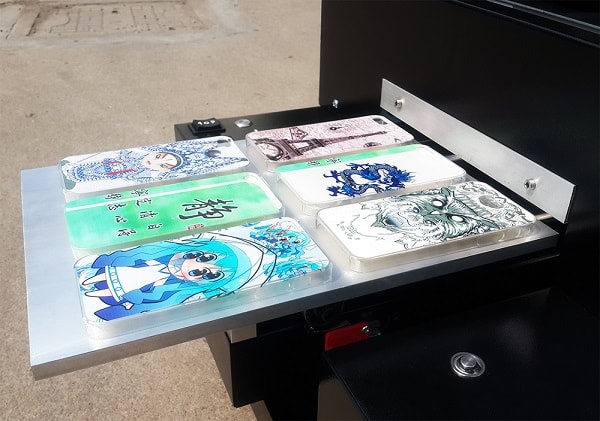
Cost savings
UV ink can be printed directly onto the substrate without pre-treatment of the print surface (printing surface coating). You can save a lot of money by excluding this step. At the same time, UV ink also produces accurate colors, making it easier to control the amount of ink used. Therefore, using UV ink will limit ink wastage.
Fast print speed
UV printing requires no surface preparation. Therefore, the printing time is shortened. Not only that, the fact that UV ink dries right in the printing process also contributes to speeding up the UV printing process. Moreover, now printing factories are equipped with large capacity flexographic printers to print labels with UV ink, printing speed can reach several hundred thousand to several million stamps/day, meeting with large capacity orders. .
Environmental friendliness
Environmental friendliness is one of the other advantages of UV printing inks. UV printing ink emits very little toxic inorganic VOCs commonly found in printing ink. Therefore, the UV printing process is safe for workers. UV printing components also ensure the health of users.
Limitations of UV printing ink
Depends on UV printing technology
UV ink cannot automatically dry without ultraviolet (UV) irradiation.
UV ink printing error is difficult to repair
Because of its strong adhesion and color fastness, if the UV printing ink is accidentally pulled out, it is very difficult to wipe it off.
UV ink is more expensive
The price for UV printing is usually high mainly because the initial investment cost of the UV printer is high, along with the higher UV printing item compared to conventional printing ink. However, in terms of application, flexibility and colorfastness, this price is also very reasonable.
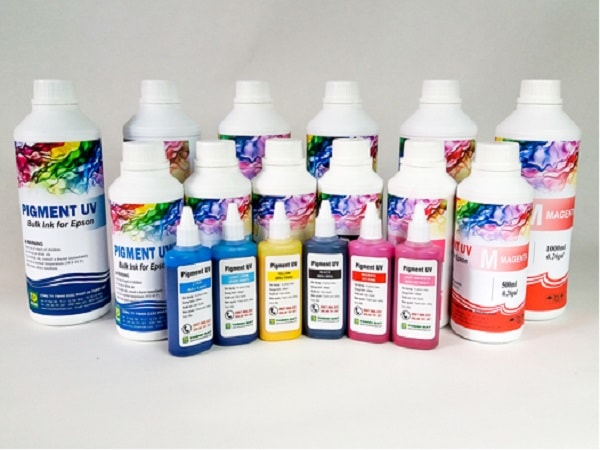
Short shelf life and strict storage requirements
UV ink has a shorter shelf life than usual. The shelf life of an ink cartridge is approximately 6 months. Along with that, the requirements for storing UV ink are quite strict: low temperature, avoiding UV exposure.
Wet UV ink can cause allergies
Printers should avoid UV inks coming into direct contact with the skin. Because, UV printing ink is easy to cause allergies.
In addition, you can also learn more:

